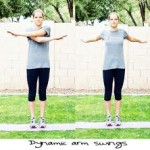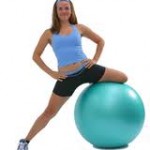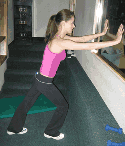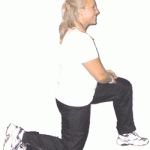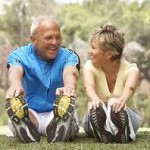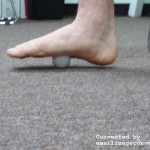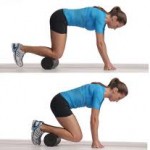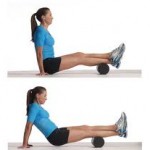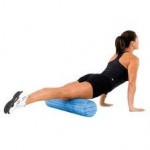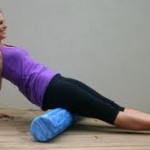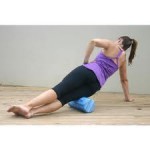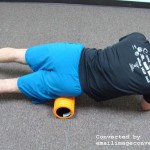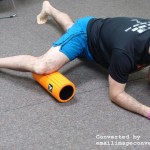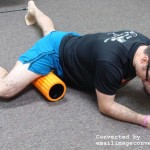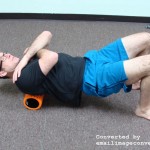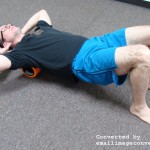Millions of older adults suffer from chronic muscle pain and stiffness on a daily basis. The causes of this functional limiting disability are many and range from previous trauma or injury from work or a sporting event, a lack of exercise due to work requiring a lot of sitting or stationary standing or just being a coach potato, repetitive strain from too much exercise or an exercise load that was too much/ too soon, poor nutrition, being overweight or a person’s inability to deal effectively with emotional stress.
Low back pain and stiffness is the most common area of complaint, affecting over 30 million North Americans yearly, but neck, shoulder, upper back, hips, upper and lower legs and feet are also frequent areas of chronic muscular disability. When a person starts to feel chronic muscle pain and stiffness often their first reaction is to become inactive. Their rationale is if it is uncomfortable and takes great effort to move then don’t move and they won’t suffer as much. The second most common response is to reach into the medicine cabinet for some Aspirin®, Tylenol® or Advil®. Unfortunately, both of these actions only treat the symptoms and not the cause.
By becoming more inactive, the soft tissues of the body, muscles, tendons, ligaments and fascia, lose their flexibility and increased tissue tension results. Medication can only chemically mask the pain and stiffness and has no restorative properties. Both inactivity and pain medication are appropriate responses to acute injury when rest and decreasing the inflammatory response is a priority but are contra-indicated when someone is suffering from a myofascial chronic pain syndrome. In these cases mobility exercises and myofascial release techniques are the treatments of choice in dealing with the anatomical and physiological problems rather than just the symptomology.
Mobility Exercises
Mobility exercising is simple; you take a joint and move it through its ranges of motion. By doing this you increase the blood circulation and nutrients through the muscles as well as dynamically stretching the muscles, tendons, ligaments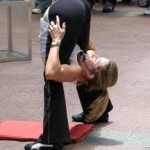 and fascia that surround the joint being mobilized. Mobility exercises not only help maintain soft tissue flexibility but also prevent scar tissue, adhesions and contracture from developing. The only thing you must be aware of is not to move a joint through pain. All your mobility exercises must be done within a pain-free range of motion. When you start out doing mobility exercises, be patient, your pain-free range of motion will improve overtime. All mobility exercises should be done slowly and smoothly at the beginning with no jerks or ballistic movements. The speed of the mobility exercises can increase as the muscles and surrounding soft tissues warm up.
and fascia that surround the joint being mobilized. Mobility exercises not only help maintain soft tissue flexibility but also prevent scar tissue, adhesions and contracture from developing. The only thing you must be aware of is not to move a joint through pain. All your mobility exercises must be done within a pain-free range of motion. When you start out doing mobility exercises, be patient, your pain-free range of motion will improve overtime. All mobility exercises should be done slowly and smoothly at the beginning with no jerks or ballistic movements. The speed of the mobility exercises can increase as the muscles and surrounding soft tissues warm up.
Static stretching should be done after your mobility exercises to help in the cool down and maintain the length of the soft tissues being exercised. Table 1 and 2 below illustrate dynamic and static exercises for the various parts of the body. You can read more about the importance and technique of dynamic mobility and static stretching at two of my previous blog articles;
- Learning About Stretching http://forever-active.com/category/fitness/flexibility-training/
- Flexibility Training at 50+ http://forever-active.com/flexibility-training-50/
Table 1: Dynamic Mobility Exercises
1. Stand tall and hold arms out to your side.
2. Slowly swing your arms back and forth across the front of your body.
3. Repeat this continuous motion for 30 seconds.
Side Bends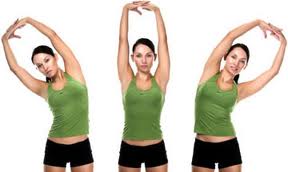
1. Stand with a shoulder width stance. Place a toning bar on your shoulders (optional).
2. Lean to one side keeping your torso straight. Do not bend forward or backwards.
3. Hold for a count of 2 and then repeat to the other side. 4. Complete 10 stretches each side.
Trunk Rotations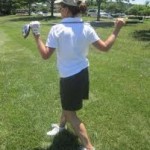
1. Stand with a shoulder width stance. Place hands on hips.
2. With knees slightly bent, turn from side to side keeping feet firmly on the floor.
4. Complete a total of 15-20 full swings.
Full Back 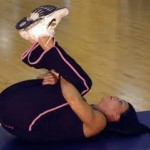
1. Lie on your back and bring both your knees to your chest with hands clasped under back of knees.
2. Roll forwards until your feet touch the floor and then immediately roll back until just before your head touches the floor.
3. Continue until you complete 10-15 full rolls.
Abdominals 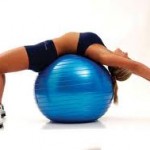
1. Start by lying on your back on a mat or the stability ball (advanced) holding a toning bar at your chest (the toning bar is optional).
2. Push back with your feet and simultaneously push the bar over and behind your head.
3. Your legs should be straight and your arms outstretched.
4. Return to the starting position and repeat for 10-15 reps.
Hip Flexion & Hamstrings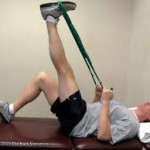
1. Lie on your back and place a piece of exercise tubing or rolled up towel (optional) around the bottom of one of your feet.
2. Pull the tubing and raise your leg at the same time until a comfortable stretch is felt. Return to the starting position and repeat for 10-15 repetitions.
3. Repeat with other leg.
Hip Abduction (Groin) & Hip Adduction (Gluteus Medius & Tensor Fascia Lata)
1. Stand upright and swing your leg across your body stretching the abductors and adductors.
1.Start by standing straight and then move your right leg out to the side and bend at the knee (advanced).
2. Return to standing upright and then cross right leg in front of left leg and bend slightly at the knee and hip.
3. Return to standing up right and then cross right leg behind left leg (advanced) and slightly bend your knees and hips (advanced).
4. Repeat sequence 1-15 times
1. Start by placing your right knee on top of a stability ball and maintain your balance.
2. Slowly spread your leg out to the side until you feel a stretch on the inside of your thigh.
3. Return to the start and repeat for 10-12 repetitions before changing to the other leg.
Alternate Toe Touches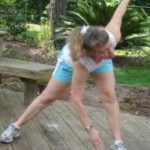
1. Start by standing with your feet spread as far apart as comfortably possible.
2. Lean forward toward one leg and try to reach your foot or until a comfortable stretch is felt in your low back and hamstrings.
3. Now try to touch the other foot with the opposite arm. This motion should be continuous alternately touching each foot (as close as possible) with the opposite hand.
Important: skip this stretch you are prone to low back pain or if it causes you any discomfort.
Leg Swings for Hip Flexors and Extensors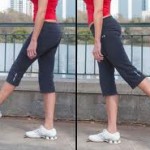
1. Start by standing with your feet shoulder width apart.
2. Keeping your upper body perpendicular to the ground swing one leg forward and backward.
3. Do not swing your leg so hard that you cannot keep your upper body from moving.
4. Repeat for 10 full swings and repeat on other leg.
Table 2: Static Stretching Routine
Myofascial Release
Myofascial Release Techniques have been shown to be very effective in treating chronic muscle soreness and stiffness. Most massage therapists are trained in myofasical release techniques and this is the most common way that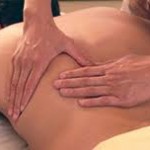 people have found relief with this technique. However, self administered myofascial release utilizing specially designed form rollers is fast becoming a popular, safe and effective way for people who suffer from chronic muscular pain and stiffness to find relief. Similar to massage techniques, the self-myofascial release technique can reduce trigger points, decrease tissue tension and break down scar tissue adhesions.
people have found relief with this technique. However, self administered myofascial release utilizing specially designed form rollers is fast becoming a popular, safe and effective way for people who suffer from chronic muscular pain and stiffness to find relief. Similar to massage techniques, the self-myofascial release technique can reduce trigger points, decrease tissue tension and break down scar tissue adhesions.
How Does Self-Myofascial Release Work
Fascia is a three-dimensional fibrous matrix interconnected throughout the body. Fascia surrounds muscles, bones and joints and provides the body structure, integrity and strength. Dysfunctional fascia is a leading cause of chronic pain, reduced flexibility and functional mobility.
Located within the muscle and tendon tissue are two sensory receptors called muscle spindle and golgi tendon organ. These sensory receptors monitor muscular and tendon tension from surrounding tissues. Stimulation of the gogli tendon organ leads to a decrease in soft tissue tension. Placing pressure directly on tight muscle tissue using deep tissue massage or self-myofasical release technique stimulates the golgi to relax tension in the soft tissue. By decreasing soft tissue tension you help break down scar tissue, tissue adhesions, increase joint mobility, decrease pain and improve overall function.
Self-Myofascial Release Technique
To perform self-myofasical release you need a form roller or small ball such as a tennis ball or soft ball.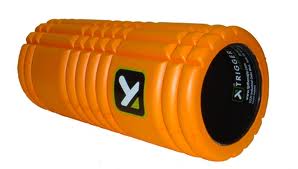
Steps:
- Place your body weight on the form roller (or ball) over the tight bands of muscle tissue that needs to be released. Start in the centre of the muscle and slowly work away from the centre.
- Relax your body, breathe and slowly roll back and forth through the length of the muscle. Your muscle will naturally tense up, especially when you roll over a trigger point, therefore go slowly and relax as you proceed.
- Once you roll over a painful spot (trigger point) stop and allow pressure into the spot (you can slightly roll back and forth over the spot if direct pressure on the spot is too painful). Continue with the pressure for 30-60 sec or until you notice a significant reduction in pain. Once the pain is reduced significantly (50%) move to the next painful spot and repeat.
It is important that you spend an equal amount of time on both sides of the body to avoid creating muscle imbalances.
Table 3 below illustrates the technique to use for the various muscle groups that are commonly known to suffer from chronic myofascial pain and stiffness.
It should be noted that the first few sessions utilizing the form roller will be somewhat uncomfortable. For effective relief it is important to be disciplined and commit to doing the self administered myofasical release massage everyday for two weeks. Slowly you will begin to notice that the muscles are becoming less sensitive to the pressure of the form roller and as the muscles and fascia heals the chronic myofascial pain will begin to subside and along with doing dynamic mobilization and static flexibility exercises improved ranges of motion and function will occur.
Table 3: Self-Myofascial Release Technique Illustrated
Summary
Chronic myofascial pain and stiffness does not have to mean chronic disability and a life time of medication. Simple, non-exerting mobility exercises and self administered myofascial release techniques have been shown to reduce significantly chronic myofascial pain and restore flexibility and function. By its definition, chronic myofascial pain and stiffness did not occur over night and long-term pain relief will take time. Good nutrition, ability to handle everyday stress and weight control should not be ignored and are important elements in helping to manage chronic myofasoical pain and should be implemented along with regular mobility exercises and self administered or professional myofascial massage.
If you’d like more info please contact Mike.

